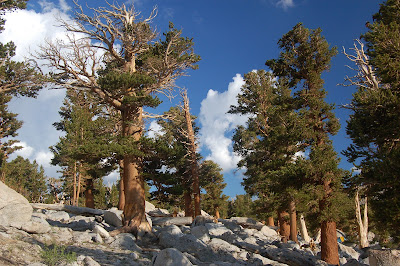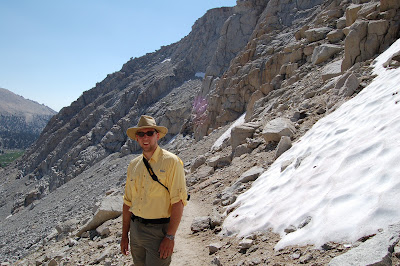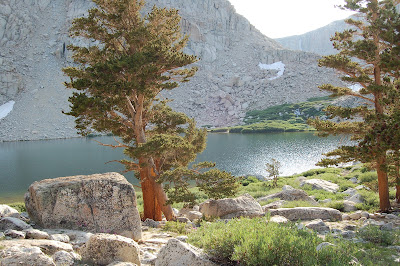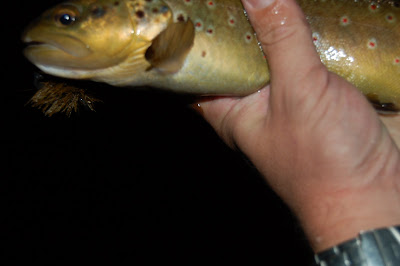The two species of golden trout that are native to the southern Sierra Nevada are arguably the most beautiful fish in the world. Others are more colorful, but not many. Others inhabit beautiful places but few as dramatic as the southern Sierras.
The three distinct species of rainbow trout Native to the Southern Sierra are called Oncorhynchus mykiss aguabonita, Oncorhynchus mykiss Gilberti and Oncorhynchus mykiss Whitei. Only the very southern most populations of these adventurous trout escaped the massive glaciers that carved their way though the Sierras. These populations were isolated in a unique and challenging environment where they evolved into the magnificent fish we see today. The most stunning being Oncorhynchus mykiss aguabonita commonly known as the Volcano Creek/ Golden Trout Creek or South Fork Kern golden trout.

 |
| A nice golden. |

 |
| A golden release |
It is easy to imagine a fish inhabiting a coral reef that is emblazoned with dramatic colors but the colors of the South Fork Kern golden trout are equally as dramatic and yet they inhabit cold water creeks high in the mountains. What set into motion the evolution of such amazing and bold color in an environment where camouflage and stealth have been driving forces for millennia? One theory is based on the presence of brightly colored volcanic rocks and cold, snow-melt water in the spring that may have influenced enzymatic pigment reactions during early fish development. However the golden trout's color pattern came to be, it is truly a feast for the eyes. Their backs are olive-gold and their sides are pure gold with purple iridescent par marks that can be retained throughout adulthood. The spots are large and dominant near the tail and their fins are tipped in crisp white. The bellies range from the brightest crimson to a fluorescent orange.
In their native range, all golden trout are voracious feeders due to a short season and nearly no fishing pressure. Dry flies are destroyed within seconds of drifting down a likely lane. Fortunately for the golden trout their native range is protected by forbidding granite guardians that soar to 14,000 feet. The lowest passes through to golden trout country are between 10,000 and 11,000 feet and once you have cleared that elevation there is still a 4 mile hike down into the valley. Golden trout can also be found in a number of lakes from the high Sierras to the Wind River range in Wyoming. While these populations are not native, the beauty and majesty of the golden trout still lure travelers and hopefully inspire people to value and protect such an amazing fish in its native range. California no longer exports golden trout eggs or hatchery trout so the remaining populations are all wild and are resources worth protecting. Please practice responsible catch and release for all golden trout regardless of location or abundance.
A few years back I visited the Cottonwood Lakes and was lucky enough to catch and photograph a few beautiful South Fork/Volcano Creek golden trout. The golden trout in the Cottonwood Lakes were initially used as brood stock for the rehabilitation of golden trout waters and, I assume, the export of golden trout to other lakes in the Sierras. Today, they are reported to be nearly pure golden trout with marginal contamination of hatchery rainbow trout. The fish in the Cottonwood Lakes do not count towards the completion of the California Heritage Trout Challenge. You have to catch each type of golden from their native ranges. The South fork of the Kern, Golden Trout Creek, or Volcano Creek for Oncorhynchus mykiss aguabonita and the Little Kern River and its many feeder creeks for Oncorhynchus mykiss Whitei.
 |
| Cottonwood lake #3. |
 |
| Muir lake, I think. |


Our trip started with a hair raising drive from Lone Pine to the parking area located in the Cottonwood meadow campground at almost 10,000 feet in the eastern Sierras. We got on the trail about 9 am and had only a 6 mile hike into the Cottonwood Lakes. Six miles with packs under normal conditions is no big deal but the rapid elevation gain really took a toll. We ran into a group on their way out, and they said they had a great trip but it rained for about an hour every day at 2 pm. I thought that was a rather specific claim and maybe they meant around two or between one and threeish but no, at exactly 2:00 it started to rain. In fact, it did rain at almost exactly two everyday we were there. After the elevation sickness and massive head aches eased, we had a great time. It is truly a beautiful place and the fish are magnificent. There was a consistent hatch every evening at about 6:00 as long as there was no wind. The lake turned to glass and it seamed that raindrops on the lake surface seamlessly transitioned to trout rising everywhere. I got a few shots of fish breaking the surface with my telephoto. The water is crystal clear.



There are five lakes in the Cottonwood chain and we caught fish in only one (Lake #3). It was the closest to the outlet stream and we were there in late July so maybe they were just coming back in from the stream after spawning. The fish were not huge but golden trout rarely are and actually, the big ones I have seen pictures of just seem unnatural, like body builders that just took things too far. The classic native and wild golden should be about 10 inches long with a sleek and slender body and colors so bright you can't do them justice in a picture.


As far as gear goes, it depends whether you are going to a lake or a stream in the native range. For the lakes, the rising fish can be a ways out. I would take a 9' 5 wt to reach fish rising and bring a 3 wt for nymphing during the day. Bring some wooly buggers to slowly strip in. If you get adventurous, try a two nymph rig with a cone head bugger as the lead fly and tie on a zebra midge trailer about 12 inches back. Cast it out as far as you can and let it settle. Make one long strip and let it settle again. For the streams, take as light a rod as you dare. I have a fiberglass 6'6" 3 wt that I built for small stream fishing. I would also take a faster action 3 wt in case the wind picks up. All dry flies will work, so take your pick. I like stimulators, ants, and parachute Adams (12-18). You could use a dropper but why? Check out the video in this post.
 |
| Feeder stream between lakes |
 |
| Cottonwood Lakes #4 and #5 |


I encourage all trout fisherman to explore the Golden Trout Wilderness and when you have seen how beautiful these fish are and how amazing the landscape they live in is please donate to California Trout or another charity that is helping to ensure we will always have native golden trout.
 |
| Day hike to the top of New Army pass |
 |
| New Army pass |
 |
| The golden trout wilderness has the best signs! Who hiked that in? |




































